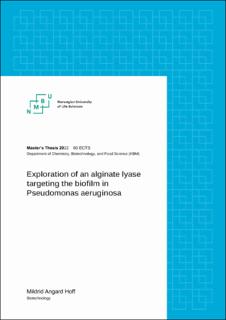| dc.contributor.advisor | Vaaje-Kolstad, Gustav | |
| dc.contributor.advisor | Edvardsen, Per Kristian | |
| dc.contributor.author | Hoff, Mildrid Angard | |
| dc.date.accessioned | 2022-11-22T08:28:25Z | |
| dc.date.available | 2022-11-22T08:28:25Z | |
| dc.date.issued | 2022 | |
| dc.identifier.uri | https://hdl.handle.net/11250/3033266 | |
| dc.description.abstract | Pseudomonas aeruginosa is an opportunistic gram-negative bacterium capable of colonizing immunosuppressed patients such as those with cystic fibrosis. A P. aeruginosa infection could lead to mortality since some strains of the bacterium can change morphology by overproducing the exopolysaccharide alginate, becoming a mucoid variant that is more resistant to host defense and medical treatment. Many of the enzymes connected to the alginate machinery have already been characterized. However, the putative polysaccharide lyase (PL) family 7 alginate lyase PA1784 is poorly described in the literature, and new treatment methods for mucoid biofilm might be discovered by testing enzymes associated with alginate. Therefore, PA1784 (renamed PaAly7a) was first purified, and then activity assays were conducted to test the activity against substrates like sodium alginate, Psl and Pet in biofilm, and purified alginate from P. aeruginosa. In addition, the sequence to PaAly7a was analyzed by bioinformatics tools, and the predicted structure was compared to the PL7 alginate lyase, PA1167. The results from the activity assays showed no signs of activity. Nevertheless, a STRING analysis showed a connection between PaAly7a and a DNase, so DNA was tested as a substrate in a DNA-degradation assay. The assay showed signs of DNA degradation, but a DNase was identified in the sample after a proteomics analysis. In addition, the results revealed that PaAly7a formed inclusion bodies when overexpressed in E. coli and that the lack of activity could have been due to improper folding of the protein. However, the melting point analysis of PaAly7a-P2 showed a melting point, indicating that it might be correctly folded. Furthermore, the predicted structure of PaAly7a showed that the active site and the area around it were tighter and more negatively charged than the active site in the PL7 alginate lyase PA1167. Despite the lack of activity, these results contribute to further knowledge about PaAly7a and the goal of finding an alternative treatment for P. aeruginosa infections in patients with cystic fibrosis. | en_US |
| dc.description.abstract | Pseudomonas aeruginosa er en gramnegativ opportunistisk bakterie som er i stand til å kolonisere immunsupprimerte pasienter, slik som de med cystisk fibrose. En P. aeruginosainfeksjon kan føre til dødsfall siden denne bakterien kan endre morfologi ved å overprodusere eksopolysakkaridet alginat. Dermed blir en mucoid variant mer motstandsdyktig mot immunforsvaret og medisinsk behandling. Mange av enzymene knyttet til alginat i P. aeruginosa har allerede blitt karakterisert, men PA1784 (referert til som PaAly7a), som er antatt å være en alginat lyase i polysakkarid lyase familien 7, er dårlig beskrevet i litteraturen. Siden nye behandlingsmetoder for P. aeruginosa-infeksjoner muligens kan knyttes opp mot enzymer assosiert med alginat, har PaAly7a blitt renset og testet. PaAly7a ble testet ved bruk av forskjellige aktivitetsanalyser og ulik substrater slik som natriumalginat, Pel og Psl i biofilmer og renset alginat fra P. aeruginosa ble brukt. I tillegg ble sekvensen til PaAly7a analysert med forskjellige bioinformatiskeverktøy, og den antatte strukturen sammenlignet med en PL7 alginat lyase, PA1167. Resultatene fra aktivitetsanalysene viste ingen tegn til aktivitet. En STRING-analyse viste at PaAly7a hadde en forbindelse til DNase, DNA ble derfor testet som et substrat i en DNA-nedbrytningsanalyse. Analysen viste tegn på nedbrytning av DNA, men DNase ble identifisert i prøven ved en proteomikk analyse. I tillegg viste det seg at inclusion bodies ble dannet når E. coli overuttrykket PaAly7a. Feil foldet protein kunne derfor forklare hvorfor proteinet ikke viste aktivitet. Imidlertid indikerte smeltepunktanalysen til PaAly7a-P2 at proteinet var riktig foldet. Videre viste den predikerte strukturen til PaAly7a at det aktive setet og området rundt var trangere og mer negativt ladet, enn det aktive setet til PA1167. Til tross for manglende resultat av PaAly7a aktivitet, bidrar disse resultatene til en økt kunnskap om PaAly7a og målet om å finne en alternativ behandling for P. aeruginosainfeksjoner hos pasienter med cystisk fibrose. | en_US |
| dc.language.iso | eng | en_US |
| dc.publisher | Norwegian University of Life Sciences, Ås | en_US |
| dc.rights | Attribution-NonCommercial-NoDerivatives 4.0 Internasjonal | * |
| dc.rights.uri | http://creativecommons.org/licenses/by-nc-nd/4.0/deed.no | * |
| dc.title | Exploration of an alginate lyase targeting the biofilm in Pseudomonas aeruginosa | en_US |
| dc.type | Master thesis | en_US |
| dc.description.localcode | M-BIOTEK | en_US |

